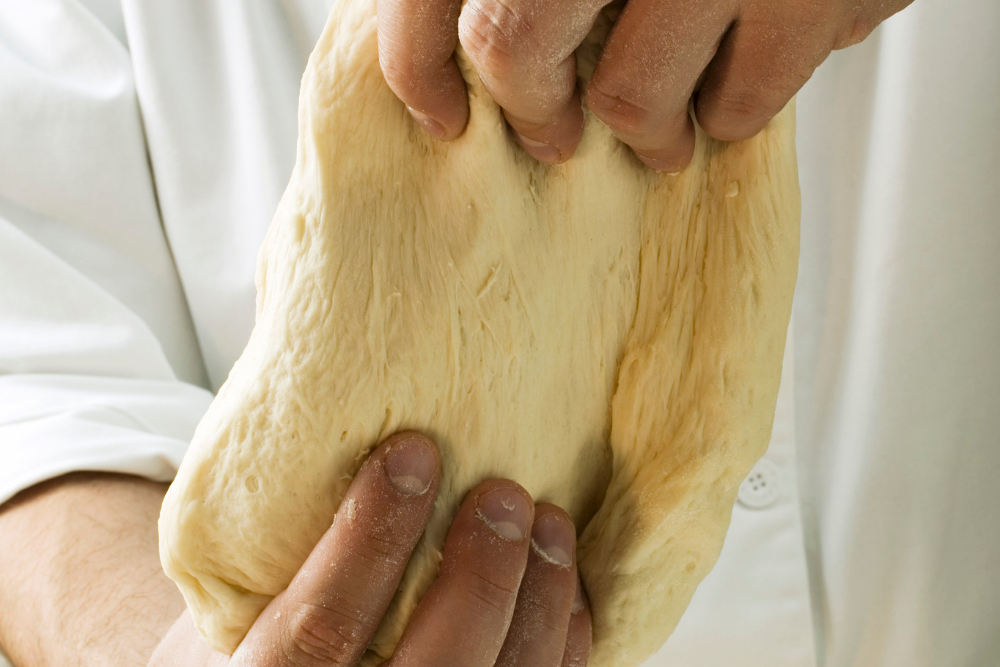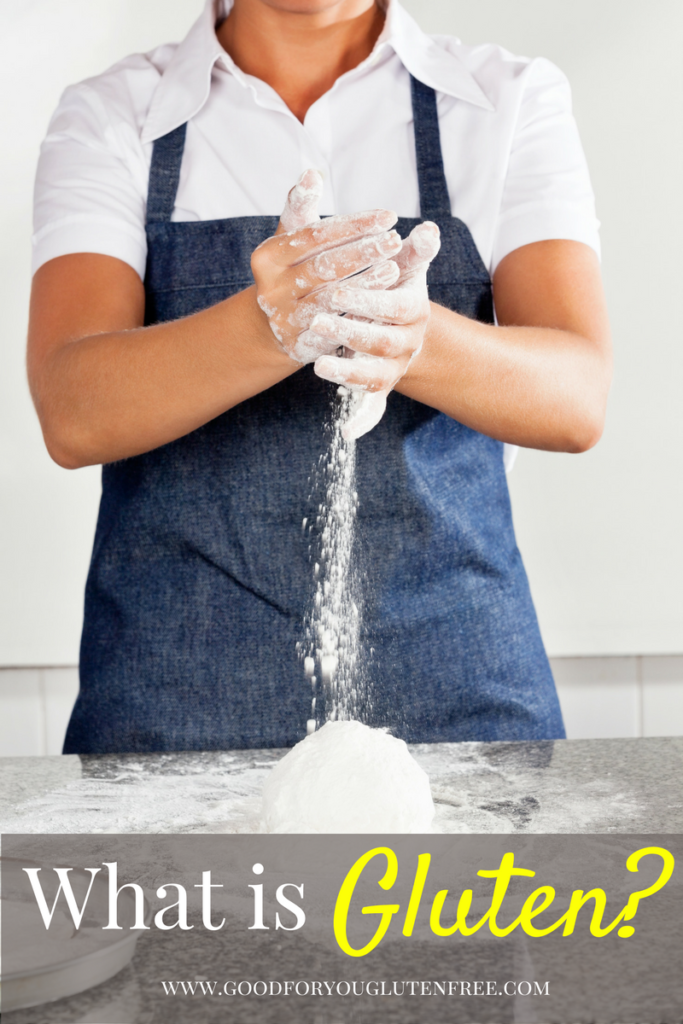
Everyone has heard of gluten, but not everyone knows what gluten is exactly. In this article, I’ll define gluten, help you easily identify gluten, and show you how to get it out of your life for good. This post contains affiliate links. Please see my disclosures.
What is gluten?
There’s so much talk about the gluten-free diet these days that you might be wondering what is gluten and why so many people are obsessed with this little protein.
Jimmy Kimmel once asked random people on the street, “What is gluten?” and he found that many people on a gluten-free diet have no idea what gluten is nor how to define it.
Watch the following clip to see how little people know about this much-talked-about protein.
If you have celiac disease or gluten sensitivity, it’s important to not only know what gluten is but also to understand where it’s found and how to identify it, as it can have dire consequences for your overall health and well-being.
In this article, I’ll not only define gluten but also help you decode exactly where it’s lurking.
What is Gluten?
Gluten is a protein found in wheat, barley, rye, and sometimes oats, as well as in derivatives of these grains.
Gluten is the “glue” that holds foods together (the word “gluten” literally means “glue” in Latin), and it’s what gives bread that elastic, stretchy, and doughy texture.
Think of a pizza maker flipping and kneading pizza dough. The dough doesn’t easily break. The reason? The gluten holds the dough together and makes it stretchy. Without the gluten, the dough would break and crumble.
While wheat, barley, and rye always contain gluten, oats do not contain gluten. Oats are naturally gluten-free, however, they more likely than not contain gluten because they are cross-contaminated with wheat.
In fact, many fields are used to grow wheat and oats, commingling the crops. The farmers then use the same farming and manufacturing equipment to handle both wheat and oats, which adds bits of gluten to the once naturally gluten-free oats. You can learn more about why oats are not always considered gluten-free in this article.
A few people with celiac disease experience gluten cross-reactivity when they eat oats and, therefore, cannot tolerate them.
Because gluten is considered an all-purpose stabilizer and binder, food manufacturers add it to many food items to make the item taste better and offer better mouth appeal.
This is why gluten is found in random places like salad dressings, gravies, and even lip balms and medications.

Gluten is often hard to detect. Ingredients such as malt (barley), yeast extract, caramel coloring, MSG, and fermented alcohol (beer) often contain gluten, as do products that don’t look like they should contain gluten, like licorice and soy sauce.
In the article, 10 Surprise Products that Contain Gluten, I identify gluten found in random products that don’t seem like they should contain gluten, but they do.
Furthermore, because gluten goes by many names, I created a free download called 100 Alternative Names for Gluten to help you identify the many sources of the stretchy protein. This cheat sheet is essential for anyone new to the gluten-free diet.
Avoiding Gluten?
If you have celiac disease or gluten sensitivity, it’s essential that you avoid gluten like the plague. Even a crumb of gluten can create inflammation in your body and deter your healing.
For people with celiac disease, gluten sets off an autoimmune attack inside their bodies. Gluten confuses the body’s immune system and causes it to mistakenly attack the healthy tissue surrounding the small intestine, an essential organ for nutrient absorption and distribution.
In people with gluten sensitivity, gluten causes chronic inflammation, negatively affects digestion, and puts someone at risk for many autoimmune and chronic illnesses, as noted in this book.
One impressive study even showed that gluten causes inflammation, which leads to intestinal permeability (leaky gut) in all who consume it, not just those with celiac disease or gluten intolerance.
The best way to avoid gluten is to eat naturally gluten-free foods prepared at home. Naturally, gluten-free foods are often some of the best foods for you and don’t include an ingredient label to decode.
Here is a short list of naturally gluten-free foods, or feel free to check out my list of 200+ Foods You Can Eat on the Gluten-Free Diet:
- Vegetables
- Fruits
- Meats
- Fish
- Cheeses
- Nuts
- Seeds
- Dark Chocolate (pure chocolate – beware of add-ins)
- Rice
- Millet
- Kasha (buckwheat)
- Potatoes
- Eggs
If you need help coming up with various delicious and gluten-free foods to make at home, I highly suggest you download some of my dedicated gluten-free meal plans to help you get started.
Remember, it’s important to prepare and eat food at home as much as possible when you’re following a medically-necessary gluten-free diet. Your risk of accidentally eating gluten is high when you eat out. Restaurant kitchens can usually accommodate you, but they are minefields for cross-contamination.
If, for example, the chef is handling sandwich bread, then s/he touches the lettuce on your dish, you can get sick. Likewise, just because something is gluten-free doesn’t mean it was prepared in a gluten-free way.
Shared fryers in restaurants are notorious for cross-contaminating your foods. French fries, which are made of potatoes and are naturally gluten-free, are often cooked in a shared fryer along with chicken nuggets, which are not gluten-free. This means the same exact oil used to cook gluten also cooked your gluten-free meal.
This is why you often find me using my Nima Sensor, a portable gluten-detecting device, to test restaurant dishes for hidden gluten. You can watch me test several dishes at the Cheesecake Factory for hidden gluten in this article. (Please note there are competitor gluten-detecting sensors – specifically ALLIS Sensor, The Allergy Amulet, and Glutrust.)
In addition to eating naturally gluten-free foods, there are plenty of packaged foods bearing gluten-free labels – anything from bread and breadcrumbs to pasta, frozen pizzas, crackers, and salad dressings.
When a food displays the “gluten-free” label, it means it contains less than 20 parts per million (ppm) of gluten, a very trace amount of gluten, per the FDA guidelines. If a product is certified gluten-free by a third-party agency, it typically contains less than 10 ppm of gluten. You can learn more about gluten-free labeling laws on packaged goods in this article.
Wheat Free vs. Gluten-Free
When something is marked wheat free, it simply means it contains no wheat. However, wheat-free doesn’t mean a product is gluten-free.
As mentioned, gluten is found in wheat, as well as barley and rye too. While the product may not have wheat in it, it may still contain gluten.
Don’t be fooled into thinking something is gluten-free when it’s only labeled as “wheat free.”
By law, food manufacturers must disclose if a product contains wheat somewhere on the allergen label, as wheat is one of the top eight allergens that must be disclosed on U.S. products.
However, a manufacturer does not need to disclose if there is gluten in the product. Remember, gluten is a protein found in wheat, barley, rye, and sometimes oats. If something is only wheat free, it may still contain gluten. You’ve been warned.
Remember that a food may contain wheat but be considered gluten-free. In fact, wheat starch and wheatgrass are considered gluten-free. Wheat starch is used in various gluten-free products found around the world, including inside many Schar products and DiGiorno gluten-free pizzas. Wheatgrass is found in many powdered juice mixes and cold-pressed juices from Suja.
Is Gluten Bad?
You may not just be wondering what gluten is, but also you may be wondering why gluten is bad for some people, particularly those suffering from celiac disease or gluten intolerances.
Gluten is bad for many people because it is very difficult to digest, and leading celiac researchers even found that gluten causes inflammation in all humans.
Further, research shows that gluten may be one of the causes of leaky gut and indigestion in many people. It takes a lot of acid in our stomach to break down this hard-to-digest protein.
To digest gluten, you may find that your stomach acid bubbles up (often causing some heartburn or acid reflux). This means the stomach is working hard to digest this difficult-to-digest protein.
Too often, people take antacids or proton pump inhibitors to queal the stomach acid from bubbling, which is doing nothing to help digest the protein and often makes matters worse.
Think of it this way, if you calm your stomach acid with antacids, your stomach acid won’t work hard to digest your food, then these undigested or improperly digested food particles enter into the next stage of digestion, which is your small intestine.
These food particles dig holes in the paper-thin small intestinal lining in an effort to escape, thereby causing food to leak into your bloodstream and forcing your body’s immune system to produce antibodies to a variety of foods.
This whole cascade creates inflammation at a part of your body where you are most genetically vulnerable, whether it’s your small intestine, brain, joints, skin, etc.
It’s why so many symptoms are linked to celiac disease, and more than 60 symptoms have been linked to gluten sensitivity.
Now You Know
Understanding gluten is imperative for people following a gluten-free diet. You need to know exactly what you’re avoiding, why you’re avoiding it, and how it impacts your health and long-term prognosis.
Plus, you don’t want to look or sound silly like the guests on Jimmy Kimmel did. The more educated you are, the more educated the world will become.
The next time someone asks you, “What is gluten?” you now know exactly what to say.
Got questions? Please leave a comment, and I’ll be sure to pop in and answer them.
Leave a Comment